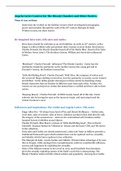Angela Carter Context for The Bloody Chamber and Other Stories:
Time it was written:
- Same time she worked on the Sadeian women which investigated pornography,
power and sexuality through the work of the 18th century Marquis de Sade.
- Written in 1979, ten short stories.
Re-imagined fairy tales, folk tales and myths:
- Have been around for centuries as an oral tradition. As early as 16 th century, writer
began to collect folklore tales and present their versions in story books. Best known:
Charles Perrault, the bloody Chamber based off of his ‘Barbe Bleu’. Based of his Tales
of Mother Goose (1697). The Brothers Grimm, William and Jacob also influenced
Carter.
- ‘Bluebeard’- Charles Perrault- influenced ‘The Bloody Camber’. Carter has the
matriarchy smash the patriarchy as the mother rescues the young girl and in
Perrault’s version, the brothers rescued her.
- ‘Little Red Riding Hood’- Charles Perrault: Wolf-Alice, the company of wolves and
the werewolf. Shape-shifting werewolves, how the patriarchy in society can be twisted
and shifted. Carter defies gender stereotypes in these stories by depicting strong
female characters that are fearless in different ways from each other. Further, the
women are not portrayed as victims but instead have a wolfish and fierce side to their
nature.
- ‘Sleeping Beauty’- Charles Perrault- LOHOL loosely based off of this tale. Carter
subverts tale by having the man as the innocent virgin, and nurturing break the
violent Countess’s curse.
Influences and inspirations: The Gothic and Angela Carter, TBL notes
- Edgar Allen Poe- ‘I'd always been fond of Poe and [Ernst] Hoffmann – Gothic tales,
cruel tales, tales of wonder, tales of terror, fabulous narratives that deal directly with
the imagery of the unconscious – mirrors; the externalized self; forsaken castles;
haunted forests; forbidden sexual objects.
- Charles Perrault- Blue Beard, versions of ‘Little Red Riding hood’, ‘Puss in Boots’.
- Gabrielle- Suzanne Barbot de Villaneuvre- beauty and the beast- CML and TB stories
in the collection.
- Fairy tales and Gothic are closely intertwined, a fairy tale’ basis in folklore provides a
traditional framework upon which modern fears can be explored such as; sexuality
and identity which Carter explores in her collection.
- The Marquis de Sade- novels Justine and Juliette. Woman taken advantage of by men
dies in despair, while amongst this a nymphomaniac achieves considerable influence,
success and happiness by exploiting her sexuality.
- Ideas of the Sadeian woman in her novel in 1979, much backlash from feminists,
given the sexually exploiting nature of the Sade’s work this is unsurprising. The
Bloody Chamber achieved both critical acclaim and popularity- showing how Gothic
, literature can explore unpalatable subjects (taboo) and challenge ideas, pushing
societal norms and boundaries, perhaps making readers feel out of their depth.
- In particular, Carter utilised fairy tales as a basis from which to explore contemporary
attitudes towards sex and gender in what was still largely a patriarchal society.
The Bloody Chamber: A fairy-tale gothic for a new age
- The bloody chamber- reference to Bluebeards room where he keeps his bloodied
brides, similar to the Marquis in the bloody chamber (reference to other texts).
Alternatively, could be a reference to the womb- source of life and sometimes people
die giving birth which was common, possible link to Mary Shelley and her thoughts
about birth, being scared to give birth as her mother died from her birth of Mary.
- Present day view- bloody chamber- sadomasochistic sexual desires of the heroine’s
new husband. Blood on the bed sheets after being a virgin. Medieval examination-
check state of female hymen and the sheets after a wedding night, grooms would be
given a white bedsheet to ‘test for virginity’.
- ‘Marquis’- Marquis De Sade. After all sex in TBC is often spoken about in relation to
violence, murder and exploitation- ‘a dozen husbands impaled a dozen brides’
- The passivity of the bride was not marked as undesirable Carter realised,
which often resulted in their death.
- The castle in which the Marquis takes the virginity of the girl is also mysterious,
isolated and dark. Like something straight from a tale of Ann Radcliffe or Edgar Allen
Poe.
- Matriarchy in TBC- mother rescues instead of the brothers in the original stories.
Intertextuality:
Intertextuality acknowledges that no text itself exists as a self-contained entity but rather as
a product of many outside influences. Intertextuality as a literary device is when authors
refer to other fictional works in their own.
Examples in Carters works:
- The Bloody Chamber: ‘Tristan and Isolde’ 12th century German poet Gottfried von
Strassburg. Lovers who end up dying for their love. In the bloody chamber, the
Marquis marries an opera singer who is famous for singing Isolde’s death aria. She is
his first victim, being so old, could possibly from an alternative perspective suggest
that the patriarchy has been forever going on. Carter suggests however that the
Marquis killed her as he she wanted her performance to seem real.
- The Erl-King: ‘Goblin Market’ by English poet Christina Rossetti (1862). In Carters
story she alludes to the poem in the line ‘he spreads out a goblin feast of fruit for me’.
In Rossetti’s poem, the eating of fruit leads the girl pining for more. This echoes the
way the narrator continuously comes back to visit the Erl-King though she knows he
could do her grievous harm.
- The Tiger’s Bride: ‘Gulliver’s travels’ (1726) by the English author Johnathon swift.
When the narrator of the tiger’s bride agrees with the fact that horses are better than
we are. Reference to the intelligent race of horses in Swift’s work. Carter defends the
thematic point that sometimes beasts are more noble than men.




